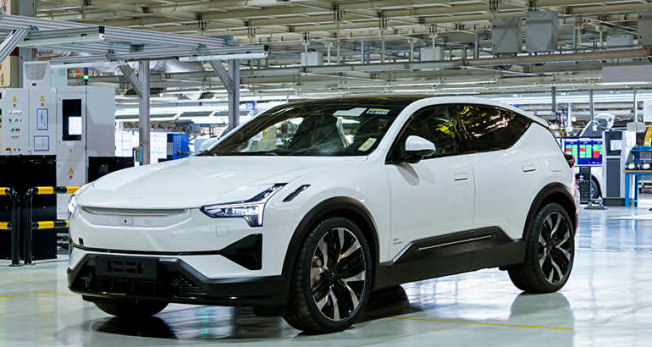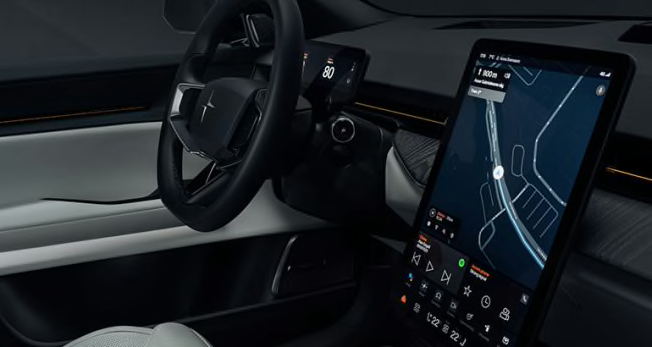2025 Polestar 3 SUV Brings Power, Luxury, and Abundant Safety Features
New midsized model is key for this emerging electric brand

The Polestar 3 SUV will expand Volvo’s electric-only sub-brand’s portfolio when it joins the 2 hatchback. This midsized model will compete directly with the recently introduced Mercedes-Benz EQE SUV, as well as the Audi E-Tron, BMW iX, Cadillac Lyriq, and other upcoming luxe SUV EVs.
The design and packaging reflect the Scandinavian pedigree, with restrained styling, an emphasis on safety and sustainability, and premium audio—all hallmarks of the related Volvo brand. Both Polestar and Volvo are primarily owned by the Chinese corporation Zhejiang Geely Holding Group (ZGH), and Polestar is now a publicly traded company.

Photo: Polestar Photo: Polestar
CR's Take
Offering a midsized SUV is essential to broadening the brand’s appeal. This conservatively styled new model promises several innovations, like available lidar, but ultimately its appeal will be hampered by the heady price and limited name recognition.
There are more Polestars coming—each with an equally meaningless moniker. Hopefully, they will expand the brand’s appeal, moving the line down in price. Starting in the $80,000 range, the Polestar 3 will face competition from more established brands, like Audi, BMW, and Mercedes-Benz.
As we have seen with the Polestar 2 we tested, this may be a challenge. That hatchback was quick, but we found it to be unimpressive in many ways. It has a bone-jarring ride, a tight interior, and confusing controls.
Outside
The exterior looks tasteful and a bit familiar. There is a bit of Volvo “Thor’s hammer” inspiration to the headlamps and a hint of XC40 to the rear. The horizontal rear light reminds of an Ikea bookshelf. Somewhat unique is the front “spoiler” integrated into the hood that Polestar says helps optimize aerodynamics. Door handles retract, and they use a proximity sensor to present themselves as the driver approaches. Standard wheels are 21 inches in diameter. Massive, and rather excessive, 22-inch wheels are optional.
Otherwise, the styling is rather generic. It won’t turn off any buyers, but it might not carve a market identity for this new brand that may struggle to emerge from Volvo’s shadow.

Photo: Polestar Photo: Polestar
Inside
The cabin embraces Scandinavian minimalism, looking clean and a bit sterile. The seats are attractively sculpted, but much of the rest of the cabin appears somewhat plain, as if it was a prototype, rather than a production-intent vehicle.
This is underscored by the thin driver display and massive, 14.5-inch vertical infotainment display, which looks like a television perched against the dashboard. A heavy reliance on large screens has proved to be problematic in other cars that we’ve tested, including the Polestar 2, Rivian R1T, and Teslas. The big screen uses the Android Automotive operating system, like the Polestar 2, enabling built-in Google services, customization and over-the-air updates to allow the addition, and evolution, of features. But any improvement in usability and simplification compared with the Polestar 2’s system will be welcome. At least it appears Polestar tweaked the infotainment software and reorganized the home screen layout slightly.
A head-up display should help offset the diminutive instrument panel.
Beyond these screens, Polestar uses other intriguing technology, including a Nvidia core computer with artificial intelligence capabilities to enhance safety and power the dual-camera driver attention monitoring, and the Snapdragon Cockpit Platform from Qualcomm to provide connected services.
The five-seat cabin is swathed in a range of sustainable materials and animal welfare certified leather. A panoramic roof adds natural light to the ambience.
For the first model year, the Plus Pack and Pilot Pack come standard, adding luxuries like a 25-speaker audio system from Bowers & Wilkins.

Photo: Polestar Photo: Polestar
What Drives It
Each Polestar 3 comes in a dual-motor configuration with all-wheel drive. The standard “long range” model has 489 hp, enabling a claimed 4.9 second 0-to-60-mph time. Polestar estimates its range at 300 miles. Official Environmental Protection Agency ratings are not available yet.
The step up to the Performance Pack sees output nudge up to 517 hp, bringing 0-to-60-mph times down to 4.6 seconds. But the range for this version is estimated to be 270 miles. Sounds like the base version is the way to go . . .
Both have a 400-volt lithium battery, with a 111-kilowatt-hour capacity, and a maximum acceptance rate in public DC fast-charging places is claimed to be 250 kilowatts. The tow capacity is 3,500 pounds. Note that towing with an EV cuts range dramatically.
The Polestar 3 has a standard air suspension that can adapt to comfort or performance, as directed by the driver.

Photo: Polestar Photo: Polestar
Safety and Driver Assistance Systems
Living up to its Volvo heritage, the Polestar 3 comes with an extensive roster of active safety features. Among the highlights are automatic emergency braking with cyclist and pedestrian detection, lane keeping assistance, lane departure warning, reverse automatic emergency braking, blind spot warning, cross traffic alert, and adaptive cruise control.
There are two cameras used for driver attention monitoring. These track the eyes, and data stays in the vehicle, rather than being uploaded to the cloud. If the driver is determined to be distracted, drowsy, or otherwise nonresponsive, the vehicle will issue a visual warning, an audible warning, and eventually escalate to stopping the vehicle.
The Polestar 3 goes beyond common, and appreciated, door-minder systems to use radar-technology to prevent kids and pets from being mistakenly left in the vehicle.
All Polestar 3s will come standard with the Pilot Pack. This adds a roof-mounted lidar system, three cameras, and four ultrasonic sensors. Combined, this equipment will enable detailed, three-dimensional monitoring of the SUV’s environment, paving the way for autonomous driving. Polestar tells CR that will make the 3 capable of Level 4 driving automation, defined as meaning the vehicle can be in full control, without requiring the driver to take control. (Learn more about levels of automation from SAE.) Until that is legally permitted, the vehicle will provide driving assistance. This system will be upgraded over time via software updates.




















